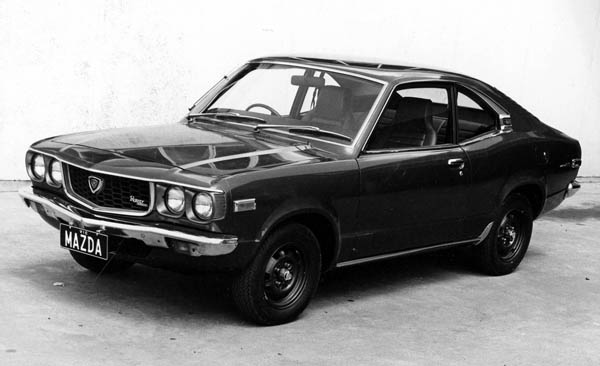
1972 Mazda RX-3
The RX3 is best viewed as an uprated, restyled R100. Its heart was still the 10A rotary,
which drove back through a slick shifting all-synchro four-speed to a live rear axle
suspended by leaf springs. To reduce its emission and noise levels, the RX3’s 10A
differed somewhat from its predecessors.
On smooth roads it could be coaxed around corners reasonably quickly, but as with its
stablemates any kind of bumps threw the RX3 quickly off line. In the wet, the leaf-
sprung rear end slid readily when the driver poured on a bit of throttle.
Enthusiasts found that by equipping the car with six-inch alloy rims and fatter European
radial tyres and also lowering the suspension a few centimetres helped. While the
handling could be sorted out by a few judicious changes, less could be done to improve
the choppy ride. In standard trim the RX3 handled noticeably better than the previous
R100 but the ride was pretty much on a par.
Whilst the handling of the RX3 was not much better than the R100 the engineers at
Mazda certainly paid attention to criticism of the steering. The recirculating ball steering
on the RX3 was much better than the R100’s. It was certainly less vague and woolly
than before so drivers could place the car much more accurately but the self-centring
feature was weak at low speeds.
Just over one turn of the wheel was needed to traverse a 50ft circle so the steering was
normally quite responsive.
A major deficiency of rotary engines was their thirst for fuel. Mazda’s marketing people
continued to point out what they saw as other advantages such as its ability to run on
standard, low octane fuel but its insatiable thirst required it to make many more visits to
the service station for a fuel top-up.
When driven really hard the best it could do was 18 miles per gallon in the old money, and
that was from a small car where owners of other comparably sized cars expected and
achieved figures in the 30-35 range.
People bought the RX3 for performance not economy. The peak torque of 100 lb/ft was
reached at 4000 rpm and there was a distinct shortage of torque at low engine speeds,
as with the R100. So, the RX3 was no top gear slogger, even though the rotary motor
remained smooth down to quite low numbers.
And what torque was available was distributed more evenly throughout the range than
had been the case with the R100. There was little action below 3500 rpm, but from this
point through to at least 8000 rpm, the 10A was a veritable little powerhouse.











